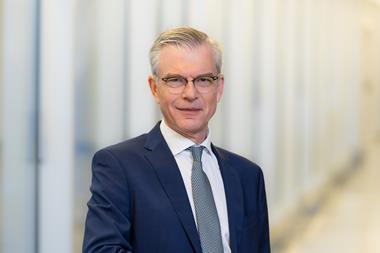Liam Kennedy concludes that the German version of fiduciary management will look different from its Dutch counterpart
I n the early years of this decade, the talk among the institutional investment community in Germany was all about the division of the value chain into its component parts, each of which was to be run by a specialist - consultant, manager, master KAG, custodian and so on.
In particular, the decision of the German banking regulator of 6 December 2001 to give formal permission for a KAG to outsource investment activities meant that investors could consolidate their mandates with one party - a construct that became known as the master KAG.
Then, the Investment Law of 2003 allowed the creation of institutional share classes in mutual funds and set off a wave of institutional diversification. Many German investors had already begun to move from a balanced approach to a multi-specialist approach in asset management, assisted by the master KAG construction. The more flexible diversification opportunities offered by mutual funds made this much easier.
So why, after so little time, is the word in German asset management boardrooms now of fiduciary management? Fiduciary management, after all, is about a rebundling of asset management services. Have the large German asset managers simply jumped on a band wagon?
Fiduciary management as a term has been imported from over the border in the Netherlands and is being adapted to fit the existing platform of the master KAG, which market players see as being well suited to the provision of an all-in institutional service.
In Germany as well as in the Netherlands, the concept is understood as the outsourcing of decision-making power for a range of services from strategic asset allocation to manager selection to reporting - albeit with strong internal governance on the part of the investor to oversee the fiduciary manager and to assess the added value. After all, this is about effective division of decision making responsibility to qualified parties - not an abdication of fiduciary duty.
Providers - among them the German asset management majors DB Advisors and Allianz Global Investors (AGI) - agree that the market is ripe for re-bundling. "What we are seeing at the moment in the market place is real sea-change," says
Nikolaus Schmidt-Narischkin (pictured right) head of pension solutions at DB Advisors in Frankfurt. "This increasing specialisation, this atomisation of the value chain, has certainly become part of the problem. It was previously seen as part of the solution because of the investor's ability to select from among different specialist providers. But then you have maybe 35 providers of 35 modules, which you, as client, have to manage together."
Tobias Pross, (pictured left) managing director for pension markets at AGI agrees with this sentiment: "Our clients are saying, we have tried five years of reporting. One comes at the 10th of the month, another is at the fifth but another cannot give us a price of the leverage and the swap pricing comes on the 25th. So the client has to get five reports on one P&L."
Pross also says that enhanced client demands, such as the proliferation of different vehicles for the various asset classes, and sub-CTAs for different countries, has made the matter highly complex. "One client wants reporting from one master KAG but then you need a pension risk management tool as well," he says. "So you have monitoring of liabilities, because you do not do an ALM every year, so you need risk management that identifies liabilities and asset pools and how they match. That bundled as a one-stop shop would be a good approach for the German market."
DB Advisors, until earlier this year known as Deutsche Asset Management, also emphasises the risk management element of its offering, and like AGI, its approach will also rest upon the master KAG construct, a business segment that the firm re-entered in 2006. Michael Fuss, (pictured right) managing director and head of distributors for master KAG at DB Advisors, says a master KAG has until now not been able to offer unified risk reporting - and also believes risk management is a key service element.
Undoubtedly, considerations such as these prompted corporates such as Henkel and Bertelsman to opt for the fiduciary concept as clients of Goldman Sachs Asset Management (GSAM). In fact, Henkel has now fired GSAM in favour of BlackRock as part of its drive to centralise the asset management for its various European pension plans. Henkel, according to its annual report, had pension assets in Germany of €1.69bn as of the end of 2006 and obligations of €2.07bn. Assets were €874m in other countries, against obligations of €1.28bn. The deal is set to be announced soon.
How will they do it?
So German asset managers are looking to position themselves as fiduciary managers - but how are they doing it and what success will they have? Pross believes his company already manages fiduciary mandates, if you understand that as fiduciary management ex the manager selection component. "Consultants usually carry out the manager selection and thereby have impact on the strategic asset allocation," he explains. "The rest of the value chain is done within AGI, so we are maybe 80-85% fiduciary."
Schmidt-Narischkin says DB Advisors also has client relationships that border on a fiduciary model. "We have our asset team, which has a good track record with modular approaches including risk overlays in one package, although no-one called it fiduciary management," he says. "Then there are some elements of the service offering of DB Advisors' existing pension solutions team that very quickly went in the direction of fiduciary management even if no-one called it so - the services of our multi-employer trust, the ability to analyse assets and liabilities or to recommend and monitor a strategic asset allocation. The whole package was on the table but was not described as fiduciary management. We are growing with the term."
In fact, both AGI and DB Advisors claimed to have put the finishing touches to their fiduciary management structures at the beginning of September. They are also starting to get the message over to clients. "The fiduciary approach is a solution-orientated approach first of all. Second, it is a modular approach," says Fuss. "The entire package is suitable for strategy-orientated conversations, and we are also holding half-day workshops for clients. After that we will know what they really need. Nevertheless, they are only likely to opt for the full package in a handful of cases, and never exactly the same package, which means this has to be customised. And things become tricky and expensive when reporting is customised."
German asset management firms are also looking for manager selection capability in preparation for the launch of their fiduciary management services. "There is a strong convergence in this field," comments Fuss. "We are entering the consulting field with our manager selection capabilities, and this is a role we simply must have because fiduciary management is offered as an open platform."
Pross says AGI could also involve its Frankfurt-based investment department for manager selection. It undertakes project development work for AGI's retail and Spezialfonds.
While the Dutch approach to fiduciary management emphasises the asset management portion of the fiduciary value chain in pension fund investing, German providers downplay this element, although both players admit that external managers will most likely be included in a typical asset manager line-up.
Competition grows
Other players are also present in the market. MEAG, the asset management arm of the Munich Re Group is another player with a fiduciary offering - one it says it has offered since 2004. Altogether, the firm runs about €176bn of assets under management of which €8bn is third party client money.
"We see in Germany a need for smaller and mid-sized companies," says Stefan Arneth, head of mandate management at MEAG. "They are often set up to do the investments themselves. Now they need to invest in IT and human resources to meet increased requirements regarding return, risk monitoring and accounting. We think that in the near future the need for fiduciary asset management will be more evident and will be a cost efficient opportunity to enhance overall profitability."
Arneth says in the MEAG fiduciary management concept the largest part of assets is managed by MEAG experts. "This is the key difference with the Dutch model," he continues. "We are the asset manager of one of the largest European liability driven investors and thus are experts in a wide range of relevant asset classes." Nevertheless, external managers can be integrated for satellite investments.
Robert Helm, managing director responsible for the institutional third party business of MEAG also emphasises MEAG's own internal capabilities which fit the more insurance-based and less risk-seeking profile of a German investor. "We have more than 60 portfolio managers and very large capabilities in risk management," he says. "So we have quite high expertise for investments in credit risks, like corporate bonds. Most important is to be aware of the incremental risk relative to liabilities.
Performance fees as standard
Outside Germany there are differing views as to the appropriate level of fees within a fiduciary structure. Anton van Nunen, author of ‘Fiduciary Management: A Model For Best Practice in Pension Funds', believes that an adequate bench-mark for a fiduciary mandate can be the risk adjusted performance of the new investment structure as against the old benchmark structure. Other fiduciary managers, such as Cardano, which has recently set up shop in the UK, believe that the development of the funding level of the institution should form the benchmark for remuneration of the fiduciary manager.
German providers do not see demand or suitability for solvency level as a fee criteria. "The criteria we have typically used are value-at-risk or insolvency proofing of a trust construction, or the extent to which we immunise a certain investment against interest rate or inflation risks," says Fuss. "In future we will have to deal with concepts of risks such as mortality although there is not such a product on the market yet.
"It is also important to achieve an alignment of interests," continues Fuss. "In my opinion this can only be achieved through performance related fees for manager selection that are paid if the selected manager performs."
Consultants on the margins?
Who will be able to compete? And will players be taken seriously? Not surprisingly, consultants have their own view of this development. "I think fiduciary management is an attempt to get closer to the traditional hunting ground of consultants," says Herwig Kinzler, head of investment consulting for Germany at Mercer. "In the end, asset managers and consultants operate in the same hunting ground. Our core strength is independence and broad research but we do not execute. So we are trying to get closer to do what asset managers do and asset managers are trying to do what they label ‘consulting'."
Kinzler continues: "If you play around with the assumptions in an ALM study some products might appear more or less favourable. So as a client you can never be sure. Typically for the amount of money I would not accept this uncertainty."
Mercer, it should be said, offers its own investment funds and offers implemented consulting services. Watson Wyatt, which bought the local consultant Heissmann last year, is potentially in the market with its Advanced Investment Solutions group, which acquired its first client in the UK this autumn in the form of the Merchant Navy Pension Fund.
"To be fair there are some elements of repackaging of what they have traditionally have done," continues Kinzler. "Some are trying to act as a truly independent adviser and some others might only just label the offering ‘fiduciary' and offer many of their own products. You always have the perception that there may be advice that is against your interest."
"A few years ago we were in the situation where people accused us only of being in a position to manage assets and not to be administrator," concedes Fuss. He observes that it will be difficult for the pure master KAGs to compete because they do not have sufficient expertise in ALM, asset allocation, LDI or inflation overlays and the such like.
Demand assessment
Germany's new fiduciary managers see demand from German corporates with a CTA construct. Typically, the larger firms have already funded some of their liabilities. Taken at face value, the planned introduction of a fair value approach for domestic (HGB) pensions accounting for unlisted firms might be expected to trigger a new wave of corporate pension funding among Germany's prosperous Mittelstand small and medium sized companies. And that could also spark fiduciary business.
But the economic climate is not set to favour a continuation of the pension funding trend among large caps that occurred over the last five or so years. Pross remains relatively optimistic though: "If the market is not favourable towards further funding of pension vehicles, then we will start with existing funded vehicles and give the corporate the approach to outsource everything so they have less administration, less reporting and fewer in-house asset managers," he concludes. "That will really mean delivering a fully fledged service product."












No comments yet